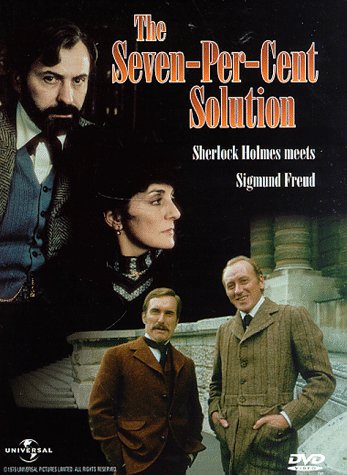The Seven-Per-Cent Solution: Apple Strudel Recipe 🥁 🥁 🥁 🥁1/2
/Year Released: 1976
Directed by: Herbert Ross
Starring: Nicol Williamson, Alan Arkin, Robert Duvall, Vanessa Redgrave, Sir Laurence Olivier
(PG, 113 min.)

"We are such stuff as dreams are made of." William Shakespeare
If you think Holmes met his match with the “Napoleon of Crime,” Dr. Moriarty, you are wrong. Watch the mental and other sparks fly when he comes under the spell of Dr. Sigmund Freud in The Seven-Per-Cent Solution. If for no other reason, rent it to see five of the finest actors of the twentieth century all together on screen.
What if the whole arch rival thing with his Nemesis Professor Moriarty is merely a figment of the “coked” up imagination of Holmes, the addict, who routinely injected himself with a seven percent solution of cocaine? Open up your mind here purists, and have a little fun.
I mean, in your inner heart, haven’t you always thought Holmes could use a few sessions on the couch? Any man so bloodless, so steely cerebral, who shuns the fairer sex and gets his jollies out of cataloguing types of tobacco, groveling in the muck with his magnifying glass, or playing melancholy harmonies on his violin could use a little time with a shrink.
But getting him there is the trick. It involves an adorable bloodhound named Toby, vanilla extract, and a long train ride to Vienna.
“My name is Sigmund Freud,” Arkin says, sounding very much like a Viennese James Bond. In fact, Alan Arkin’s Sigmund Freud is so fine, he could have given the real doctor some pointers on how to play the part. Once Holmes discovers that Freud’s goatee is for real and not some “ridiculous disguise” worn by Moriarty, his drug-addled brain reasserts itself.
After a moment, he looks around Freud’s dusty “private study” – even the maid and her dust mop are barred – and says, “Beyond the fact that you are a brilliant Jewish physician who was born in Hungary and studied a while in Paris, and that certain radical theories of yours have alienated your medical colleagues, I can deduce little else, You are married with a child of five. You enjoy Shakespeare and possess a sense of honor.” Even the father of psychoanalysis is impressed.
Now here’s the hard part for those of us who honor the legendary detective, are reassured by his certainty, and even admire his well-founded arrogance. To get over his addiction Homes must be reduced to a cowering victim of his unconscious and the hallucinations that haunt him. The ferocious hound of the Baskervilles snaps its fangs at his sweat-drenched face as Holmes tosses feverishly. Members of the Red Headed League surround his bed and watch his flailings without emotion. But it is the swamp adder, the deadliest snake in India – and that’s saying a lot – the loathsome creature from “The Adventure of the Speckled Band,” that haunts him the most. Sometimes it has the face of Professor Moriarty. “The serpent from Eden,” Homes mumbles.
Spoiler Alert: The following discloses some plot details you may wish to find out for yourself.
He is over the worst. The only time one time math tutor Professor Moriarty was an evil genius, Holmes reluctantly admits, “...was when it took a full three weeks for him to make clear to me the mysteries of elementary calculus.”
Still, he must stay close to Freud, who will have to use hypnosis if the addiction reasserts itself. For safekeeping he takes Holmes with him when he is summoned to the bed of a patient he thought already cured of her addiction. She is ”Lillie of the Lilies,” the lovely Laura Devereau, (Vanessa Redgrave) who somehow manages to make a Viennese accent as alluring a schnapps and strudel. She has been abducted and forced to resume her drug habit, all of which Holmes, of course, instantly deduces before she wakes up to confirm everything he says. But he is still teetering on the edge, and subject to cocaine craving.
There’s a particularly riveting scene when Holmes feels the drug cravings very strongly and asks the doctor to hypnotize him, but just then the prime suspect walks away. They follow him through an assortment of polished halls but finally end up in a large enclosure with dirt floors. Holmes can put it off no longer. Freud takes out the swaying gold watch and puts Holmes under just as a gleaming white team of Lipizzaner horses charge. “The smartest horses in the world, and trained to kill,” Freud tells Watson encouragingly, before directing the limping doctor (you remember his injury from Afganistan) to “distract them.”
Besides the thrashing hooves, our threesome have other worries. Ms. Devereau has left the hospital, but Holmes and Watson trace her Hansel and Gretel trail of lilies to a lively location – a brothel. Holmes looks for her behind a closed door and finds a situation too lurid for Watson’s eyes. “The queen wouldn’t like it,” he tells his friend. When they do get to the right room, Freud has gotten there already, not by mindlessly following a trail of lilies, but by using Holmes’ powers of deduction and predicting the best place to hide a stunningly beautiful lady would be among other stunningly beautiful ladies.
Holmes does not take Freud’s intrusion into his area of expertise as well as the noble doctor had the counterpart. The two argue about their next move, when Watson reminds them that a woman is in danger.
In a casebook example of a Freudian slip, Holmes replies, “Women are always dangerous.” He then lifts his magnifying glass to his eye like a king picking up his scepter and announces, “I am on the case and now you must follow my instructions.”
Our boy is back! He even has time to scold his partners in crime (detection) that they see but do not observe, and to intone the old one about eliminating the impossible to reveal the truth, however improbable. Holmes then punctuates this rehash of his methods by dropping to the floor to examine tobacco particles with said magnifying glass, which also captures the telling details of a particular red textile. CSI Vienna here we come.
To rescue our red headed beauty, they commandeer a train to Istanbul that they playfully dub the Orient Express, where lessons learned in a tennis match save the day.
But it is the journey into Holmes’ dream world that is the real ride. Holmes gives Freud a peek into his unconscious in payment for curing him, and we finally learn the meaning of the images that have haunted him and teased us throughout the whole picture, as well as the root of his suspicion of women, and a few more wrinkles on the meek mathematics tutor, Moriarty. This is a must see for anyone who has ever longed to be in the brain or on the couch with Sherlock.
—Kathy Borich

Film-Loving Foodie
It’s not just that Laura Devereau’s voice is as sweet as strudel. This light pastry is a staple at the Freud family table and the ultimate comfort food in Vienna.
In this lovely city it is said that in the making of a perfect apple strudel, the dough is stretched so finely that a love letter may be read through it.
Apple Strudel
1 1/2 cups bread flour or all-purpose flour
1 egg, lightly beaten
1/2 cup unsalted butter
1 cup fresh bread crumbs
1/4 cup sugar
2 teaspoons ground cinnamon
1 1/4 lb. cooking or very tart dessert apples (about 4 medium)
1/2 cup golden raisins
Confectioners' sugar, for dusting
Sift the flour and a pinch of salt into a large bowl. Make a well in the center, add the beaten egg and 1/4 cup warm water, and mix with your hands to a smooth dough. With the bowl tipped to one side, and with open fingers, beat the dough, rotating your wrist. The dough is ready when it pulls away from the bowl and is difficult to beat. Place in a clean, lightly floured bowl, cover and leave in a warm place for 15 minutes.
Melt half of the butter in a skillet. Slowly fry the bread crumbs until golden brown, then set aside to cool in a bowl. Mix the sugar and cinnamon in a small bowl. Preheat the oven to 350 degrees F.
Thoroughly flour one side of a large clean dish towel, place the pastry on top and, with your fingers, gently stretch the dough to a large rectangle about 24 x 20 inches; cover with another dish towel and set aside for 15 minutes. Melt the remaining butter and set aside.
Peel, quarter, core and thinly slice the apples and combine with the bread crumbs, cinnamon mixture and raisins. Brush the dough liberally with the melted butter, then sprinkle the apple mixture all over the dough. Trim away the thick edge with a pair of scissors.
Pick up the dish towel from the shorter side, and push away and down from you to lightly roll the strudel up like a jelly roll. Tip the strudel carefully onto a baking sheet, seam-side down or to one side. Leave the strudel straight, or curve it lightly into the traditional crescent. Brush the pastry with any remaining butter.
Bake for 35-45 minutes, or until crisp and golden. Cool, slightly, sprinkle with confectioner's sugar and serve warm with vanilla custard, ice cream or whipped cream served alongside.
Recipe Source: Le Cordon Bleu Home Collection - Desserts
















